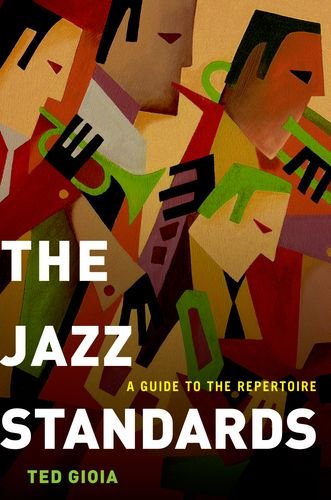 Self-teaching is an important part of learning jazz. Even in a university setting, a music professor can suggest books and recordings for a student to learn, but any student who is serious about the music is expected to discover and absorb much more of the music on their own. Given the vastness of jazz, it is inevitable that a student will seek guides to ensure that they follow a proven path. These could include the older friend who loans the student a pile of old jazz LPs, the fellow student who hips him to a classic Blue Note album, or a family member that recalls their favorite musicians. Of course, there are plenty of commercially-available options, including books about jazz history and its musicians, recorded compilations such as “The Smithsonian Collection of Classic Jazz”, play-along scores and recordings from Jamey Aebersold, and websites like Jazz History Online.
Self-teaching is an important part of learning jazz. Even in a university setting, a music professor can suggest books and recordings for a student to learn, but any student who is serious about the music is expected to discover and absorb much more of the music on their own. Given the vastness of jazz, it is inevitable that a student will seek guides to ensure that they follow a proven path. These could include the older friend who loans the student a pile of old jazz LPs, the fellow student who hips him to a classic Blue Note album, or a family member that recalls their favorite musicians. Of course, there are plenty of commercially-available options, including books about jazz history and its musicians, recorded compilations such as “The Smithsonian Collection of Classic Jazz”, play-along scores and recordings from Jamey Aebersold, and websites like Jazz History Online.
“The Jazz Standards” is a new book that guides the reader through the most popular and important songs in the jazz repertoire. The author, Ted Gioia, is an exceptional jazz historian and—nearly as important in this context—a professional jazz musician. Gioia discusses 252 standards by jazz and pop composers, any of which could turn up on a typical jazz gig. Using a relaxed, personal style, Gioia writes about the historical backgrounds of the songs, their most influential recordings, and his own experiences in performing the songs. Each 3-5 paragraph essay is followed by a list of recommended recordings (some of the recordings are not discussed in the text). In the opening pages, Gioia writes that his selection of recordings were based on “historical importance, influence on later artists, inherent quality and originality of conception”. While reading this book, I found that several of my favorite recordings were not included. However, this is not my book, but Gioia’s, and all I can do is recommend that readers listen to the tracks that Gioia suggests, but then continue their journey by seeking out other versions (several of Gioia’s picks can be found in this extensive Spotify playlist).
Most of the songs Gioia discusses are well-entrenched in the jazz repertoire through their appearances in “The Real Book” and Aebersold’s play-along collections. The songs come from composers ranging from Sigmund Romberg to Antonio Carlos Jobim, with plenty of originals written by jazz musicians. To add historical perspective, there are also several older songs which Gioia admits are only played by Dixieland bands. Gioia laments that he included few songs written after 1970, and he argues that the changing nature of popular music has led to narrow melodic ranges created for untrained voices. Still, there are good jazz songs written in the present time, and Gioia has left out worthy—and frequently played—contemporary pieces by Clare Fischer (“Pensativa”), Dori Caymmi (“Like a Lover”), Dave Frishberg (“I’m Hip”) and Ivan Lins (“Love Dance”). Of course, a book like Gioia’s will call for frequent revisions, and in future editions, he may include more contemporary songs and prune out some of the Dixie warhorses.
Gioia’s book is packed with great information, and it is as effective for leisurely reading as it is as a reference book. How many jazz fans recognize that the title “Jitterbug Waltz” was an oxymoron in its time or that “Softly, as In a Morning Sunrise” was originally written as a tango? Both of these observations make perfect sense when you think of them, but it takes an astute author like Gioia to point them out. He is not afraid to vent his opinions (although he seems a little harsh on simple melodies like “Tea for Two” and “Come Rain or Come Shine”), and he shares his confusion about songs that became popular despite their sophisticated structures (like “Willow Weep for Me”). As a helpful sidelight, he also differentiates songs that share the same title, including “Time After Time”, “Peace” and “Milestones”. Since the book is aimed at working jazz musicians, it might be a good idea for a future edition to include the commonly performed keys of each song.
Gioia writes that “The Jazz Standards” is the book he wished for when he was learning to play jazz. It will doubtlessly become a major reference for musicians who want to learn about a song’s origins and/or include a few historical facts when they introduce a song from the stage. Its wide appeal to jazz novices and veterans should make this book a must for their personal libraries. There are very few books like this on the market today, and few authors like Ted Gioia who could create it. Gioia is to be commended for filling this historical gap.
Disclaimer: My name is included in the acknowledgements to “The Jazz Standards”, as I proofread several of the articles prior to publication. I gave Mr. Gioia my honest opinions at that time, as I have done in this review. There was no compensation involved in this activity.